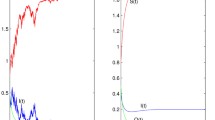Summary
A theorem, analogous to the continuous time Threshold Theorem of Kermack and McKendrick, is proved for a certain discrete time epidemic model. This model, in contrast to its continuous time analogue, leads to some solutions in which the total population of susceptibles may become infected in a finite time.
Similar content being viewed by others
References
Gani, J.: Some problems of epidemic theory. J.R. Statist. Soc. A, 141, 323–347 (1978)
Kermack, W. D., McKendrick, A. G.: Contributions to the mathematical theory of epidemics, I. Proc. Roy. Soc. A 115, 700–721 (1927)
Kendall, D. G.: Deterministic and stochastic epidemics in closed populations. Proc. Third Berkeley Symp. Math. Statist. Prob. 4, 149–165. University of California Press 1957
Author information
Authors and Affiliations
Rights and permissions
About this article
Cite this article
de Hoog, F., Gani, J. & Gates, D.J. A threshold theorem for the general epidemic in discrete time. J. Math. Biology 8, 113–121 (1979). https://doi.org/10.1007/BF00279715
Received:
Issue Date:
DOI: https://doi.org/10.1007/BF00279715




